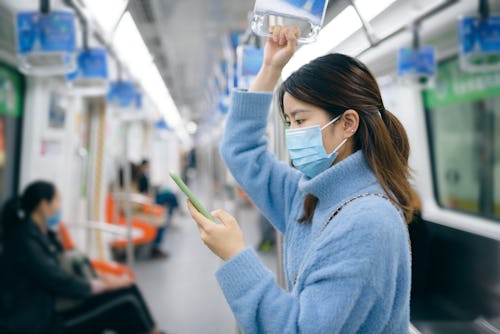Health
Doctors Explain How To Stay Safe Traveling By Train Right Now
If you don't need to travel, don't.

As states continue to reopen, finding ways to safely travel is becoming a necessity. This is true whether you plan to return home this summer or are trying to keep some of your vacation plans in tact. If you're wondering if you can travel safely during the COVID-19 pandemic, the answer isn't a simple yes or no.
Like with any other outdoor activity, spending time in public spaces and interacting with others poses an inherent risk. “We cannot definitively say that it is safe to travel right now,” Natasha Bhuyan, MD, family physician and west coast medical director at One Medical, tells Bustle. “It depends on a few factors, including the spread of COVID-19 of both your departure and destination locations.” If you are traveling to or from a place with increasing coronavirus cases, you'll need to be particularly cautious of how you travel.
The mode of transportation also impacts the level of risk. Crowded modes of transportation like subways or trains are riskier than, say, a personal car, Bhuyan notes. Transportation services like Amtrak have released coronavirus safety measures in order to keep employees and riders safe when they need to travel. These guidelines include things like requiring customers to wear masks and suspending or limiting certain routes. There are also individual measures you can take to keep yourself and others safe.
Understand The Risk
"You are coming into contact with a potentially large number of people," Dr. Jessie Abbate, an infectious disease biologist from Virginia and research associate at the French National Institute for Development, tells Bustle over email. "For trains and other common transport (bus, metro, airplane), this includes interactions at the departure and arrival stations, as well as those sitting near you in transit.” Acknowledging the risk, without going into full-out panic mode, will help you be more aware of possible exposure as you travel.
Wear A Mask When You Can’t Social Distance
Because you may not be able to stay the recommended six feet away from others, Bhuyan says, it's imperative you wear a mask to protect yourself and others. To make your mask is effective, it needs to cover your nose and mouth whenever you are in public. As Mayo Clinic states, wearing a face mask helps slow the spread of coronavirus when combined with other preventive measures like social distancing and frequently washing your hands. Speaking of which...
Wash Your Hands & Limit Contact With Shared Surfaces
Try to avoid touching as many shared surfaces as possible (e.g. poles on subways, turnstiles, public bathrooms). Bhuyan says to “wash your hands frequently with soap and water. Traveling is the ideal time to utilize hand sanitizer as you may not have consistent access to a sink. Remember to pack a travel size bottle with you when you take the train.
Consider Self-Quarantining After Travel
Both Bhuyan and Abbate recommend only traveling if absolutely necessary. The more people you are around, the higher the risk of exposure. Additionally, you run the risk of bringing the virus back home if you’re traveling far. “Some regions still require people to stay at home for 14 days after they travel,” says Bhuyan. According to UC-San Diego Health, COVID-19 symptoms can start showing anywhere from two days after exposure to two weeks. Remember, even if you aren't showing symptoms, you can still transmit the virus or you may be an asymptomatic carrier.
A good rule of thumb is if you don't need to travel, don't. And if travel is unavoidable, make sure you do so with caution and with your and others’ safety in mind.
Experts:
Dr. Jessie Abbate, an infectious disease biologist from Virginia and research associate at the French National Institute for Development.
Natasha Bhuyan, MD, family physician and west coast medical director at One Medical.
This article was originally published on